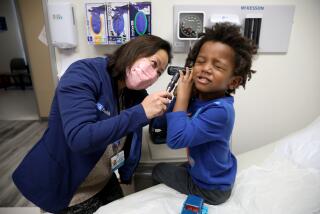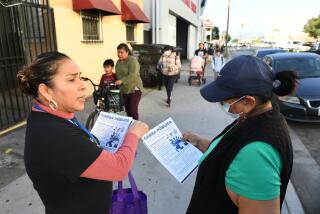Uninsured find their own clinic next door to emergency room
- Share via
Grand Junction is heaven for patients with no health insurance, compared to most places in America, at least according to Michael Ervin.
Patients in this Western Slope city pay as little as $7 for a visit to the doctor. They enjoy the benefits of preventive care and ready access to specialists.
Ervin was 55 when he left his job as an advertising account executive for a simpler life and shorter work hours in Grand Junction. He soon found himself with a major illness requiring neurosurgery. Recovery took a year, which cost him his new job.
Then he could no longer afford his $1,000-per-month health insurance premiums.
He considers himself extremely fortunate that he then found the Marillac Clinic, which is part of the network in Grand Junction that is being studied as a model for care, and post-health-care reform.
“It is an incredible, absolutely great situation,” said Ervin, now 66. “My care was superb.” Most of his office visits cost just $15 to $25, depending on his income at the time.
How it’s done
Marillac’s main sponsor is the Sisters of Charity of Leavenworth, which also runs St. Mary’s Regional Hospital in Grand Junction. The hospital contributes $1.5 million a year to Marillac in cash, space and upkeep, and the Sisters of Charity contributes $845,000. The state of Colorado contributes $1.2 million, although that was cut by $500,000 in 2009 because of budget shortfalls. Other donations total about $300,000, and Marillac officials are hoping to boost that amount to make up for the state shortfall.
Fees collected from patients, ranging from $7 to $50 or more at a time, total $1.5 million a year.
Noticeably absent from that list: federal subsidies for clinics like this, and the federal insurance program for the poor, Medicaid.
In most places, Medicaid patients flood such clinics because they can’t find a doctor willing to take its low fees.
The physicians of Grand Junction gladly serve Medicaid patients, however, because the major insurer pools private and government payments and pays the doctors the same for each patient. And that means Marillac needs only serve uninsured people who are not poor enough for Medicaid’s low income limits.
It also means Marillac also avoids the mountains of paperwork, required by Medicaid and federal subsidies. That is the secret to its success, said Dr. Steve Hurd, executive director. That ominous paperwork “would impair our ability to deliver services” because it would force doctors to pigeonhole each patient into a Medicaid procedure code.
“We are about relationships and the time it takes to learn who it is we are serving,” Hurd said. “We get to know them as a person and learn about their needs, not just their codes.”
If a patient arrives at Marillac with a medical problem, a doctor might quickly diagnose that patient needs dental work as well, and perhaps another previously undiagnosed condition. The patient might see three different professionals that day and be signed up for continuing treatment.
“Our goal is to take the time to find out all that is going on with the patient, whether there are emotional issues, whether the children are in trouble,” Hurd said.
Not simply altruism
The integrated approach pays off: A study found that Marillac cut hospitalization of its 8,000 patients from 9 percent to 4 percent in five years. Those using the emergency room dropped from 22 percent to 13 percent.
St. Mary’s Regional Hospital helps pay for the clinic because it keeps the uninsured out of its emergency room for non-emergencies, saving the hospital millions of dollars annually.
“We provide 3,000 urgent care visits a year that otherwise would have been uncompensated care at their ER,” Hurd said. “It requires tremendous community support. The community willed its existence because they wanted to have a place where the uninsured can go.”
And it wasn’t simple altruism. “We all pay that hidden tax with our premiums, our higher deductibles, all forms of taxes we pay,” Hurd continued. “Our community understands that Medicare and Medicaid and unreimbursed care are expensive.”
Patients pay Marillac on a sliding scale, an average of just 21 percent of the actual cost of care. Those who are living at the poverty level might pay $7 for an office visit. Those at 250 percent of poverty might pay $40. But that one $40 visit could include visits with a doctor, a dentist and a mental health specialist.
Three employees help people find brand-name medications for free or at a steeply discounted price—a total of $5 million worth of medications annually.
When Marillac patients need a specialist, “We have a whole cadre of specialists who volunteer” to treat the patients, Hurd said. “The specialists also want to know that … after they care for them, they’ll continue to get services. They know that because he is a Marillac patient he has a medical home.”
Under one roof
Marillac is part of the county-wide electronic medical records system, so when a patient is referred to a specialist, that heart surgeon or orthopedist has all the electronic records in front of him or her and “can get right to work,” Hurd said.
Ervin spent seven years getting his care from Marillac. “During the seven years I was there, I didn’t have a super-serious illness, but they were like my primary-care physician,” Ervin said. “I’d go there for shots, checkups, dental, the whole thing.
While using Marillac, he was able to get Lipitor for $1.75 per month through a manufacturer’s discount program — rather than the typical $300 a month.
“Where they really helped was in preventive care,” he said. “Many years ago, I took responsibility for my own health, in getting advice to do things to stay healthy. A lot of regular doctors don’t have time to give that advice.
“But at Marillac, that is a big part of the program. I’d go every three months and discuss things withy my doctor, things I could do to stay healthier. Sometimes, it would just take the normal 15 or 20 minutes, but if we had a bunch of stuff to talk about, we could be there as much as an hour and a half. How many private doctors have that much time?”
“They are smart enough to realize it’s much more cost-effective to spend time to help keep people healthy rather than just to treat them when they are sick,” Ervin said.
If Hurd could export anything about Marillac, he said, it would be “putting dentists, optometrists, physicians and mental health providers under one roof” and have them talking to each other.
‘Are you worried about your sister? I have someone right here who can talk to you about your sister right now,’” Hurd said. “Can’t afford food? I know someone in the community who can get you in touch with a food bank.’
“We are so interconnected. And it works both ways. If someone has trouble with a utility bill, but looks sick, too, the guy from the utility company will call us.”
--
Bill Scanlon’s reporting on this package of stories was funded by The California Endowment Health Journalism Fellowships.
More to Read
Inside the business of entertainment
The Wide Shot brings you news, analysis and insights on everything from streaming wars to production — and what it all means for the future.
You may occasionally receive promotional content from the Los Angeles Times.










